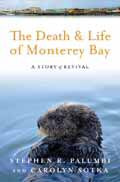SEJournal Online is the digital news magazine of the Society of Environmental Journalists. Learn more about SEJournal Online, including submission, subscription and advertising information.

BookShelf
The Death & Life of Monterey Bay: A Story of Revival
By Stephen R. Palumbi and Carolyn Sotka
Island Press, $26.95
Reviewed by JENNIFER WEEKS
People are both villains and heroes in The Death & Life of Monterey Bay, which recounts how humans first despoiled this scenic stretch of central California coastline and then helped it recover. Today, Monterey Bay is an eco-travel destination anchored by a world-class aquarium — but as Stanford University professor Stephen Palumbi and NOAA outreach officer Carolyn Sotka show, it wasn’t always that way.
In his 1945 novel Cannery Row, John Steinbeck described Monterey’s fish-processing factories as “a poem, a stink, a grating noise ... the gathered and scattered, tin and iron and rust and splintered wood, chipped pavement and weedy lots and junk heaps, sardine canneries of corrugated iron.” Fifty years ago, the stench of cannery waste turned residents’ stomachs and swarms of flies buzzed over the beaches. Now Monterey Bay is a national marine sanctuary, home to sea lions, otters, great white sharks, humpback whales, and dozens of other marine and bird species.
Humans started exploiting the bay in the late 1700s, when French and American explorers developed a lucrative business shipping sea otter pelts across the Pacific to China. By the 1840s, otters were nearly eliminated along California’s coast. Whales were next: from 1850 through about 1870, whalers took hundreds of gray and humpback whales off of California and Mexico, until the populations collapsed.
In the early 1900s, manufacturers started building canneries along the Monterey waterfront to process sardines, which migrated up the coast in summer to spawn. The market for canned fish was limited but Norwegian canning expert Knut Hovden introduced a new product line: “reducing” fish heads, tails, guts and skin into meal that could be processed into fertilizer and livestock feed. Reduction was cheap because it didn’t require much labor, and the market for fishmeal was unlimited. Monterey became a cannery town.
Anyone who has covered fisheries knows what happened next: fishermen ignored warnings from regulators about limiting their catch and insisted that the sardine supply was inexhaustible. By the mid-1940s, catch levels started fluctuating wildly from year to year, and then takes fell — from 250,000 tons in 1941 to 26,000 tons in 1946 and 49 tons in 1953. Drawing on recent research, the authors show that an irregular cycle called the Pacific Decadal Oscillation turned water temperatures colder in the mid-1940s, driving sardines southward and intensifying the pressures brought on by overfishing.
With the fishing industry shut down, Monterey Bay gradually cleansed itself of fish guts and cannery waste during the1950s. But it was devastated underwater too: without otters to keep them in check, sea urchins had multiplied, devouring kelp forests that sheltered juvenile fish and shellfish. The only exception was a five-mile swath of underwater refuge created in the 1930s by Julia Platt, the progressive mayor of Monterey’s neighboring community of Pacific Grove. Platt, who had earned a doctorate in zoology in Europe in 1898, persuaded the California legislature to let Pacific Grove manage its own coastline, and then pass a local law barring most fishing in what became the Hopkins Marine Life Refuge.
Platt didn’t live to see her bet pay off, but in 1962, a small population of sea otters that had survived along California’s remote Big Sur coast ventured north into Monterey Bay. They feasted on shellfish in the refuge and quickly spread across the bay, stripping urchins from the sea bottom. As the authors point out, scientific literature is full of so-called trophic cascades, where removing one key species from an ecosystem triggers other harmful effects down the food chain. Here the opposite happened: the “reconstruction of an ecosystem, link by ecological link.” Otters returned and ate urchins, which let kelp forests regrow, which brought back fish, sea lions and birds.
Today the former Hovden cannery building houses the Monterey Bay Aquarium, built with $50 million from the Packard Foundation and run by Julie Packard since its opening in 1984. The founders bet rightly that visitors would come to learn about Monterey Bay’s ecology; today the aquarium is the economic anchor of Monterey’s rebirth. After months of BP oil spill coverage, this book is a welcome reminder that sometimes ecosystems can bounce back from years of harm and indifference — and that people can learn to see their real value.
Freelancer Jennifer Weeks lives and writes in Watertown, Mass.
* From the quarterly newsletter SEJournal, Winter 2010-11 issue.













 Advertisement
Advertisement 



